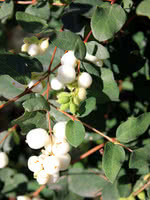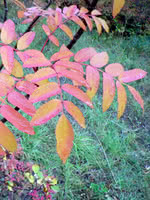Mon-Fri 9am - 5pm Mountain time
Common Snowberry vs Western Mountain Ash
Symphoricarpos albus
Sorbus scopulina
NOT AVAILABLE THIS SEASON - MIGHT RETURN
Common Snowberry is a small deciduous shrub with characteristic white to pink flowers and clusters of white fruit.
This North American native species is very adaptable, and can be used for erosion control in riparian and restoration areas. Snowberry's fruit attracts wildlife, and livestock can consume the berries without issue.
Western Mountain Ash is a popular ornamental tree native to the western part of North America. Its attractive, white clusters of flowers bloom in early summer, making way for red, yellow or orange fruit in the fall. If the fruit doesn't catch your eye, Western Mountain Ash's autumn colours will capture your–and the birds's–attention.
Common Snowberry Quick Facts
Western Mountain Ash Quick Facts
Toxicity: berries toxic to humans

